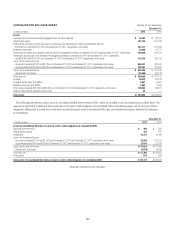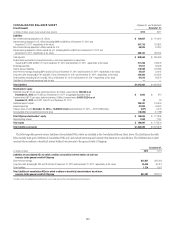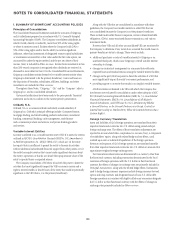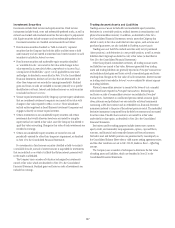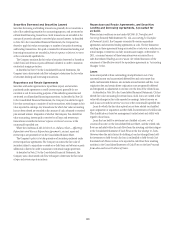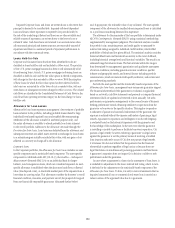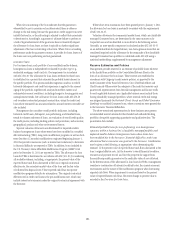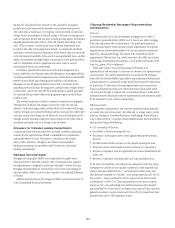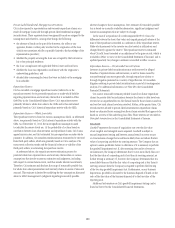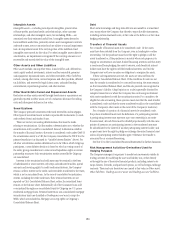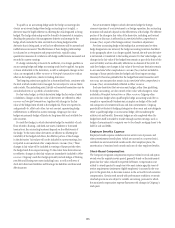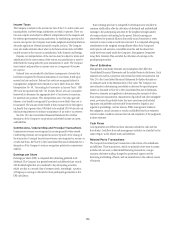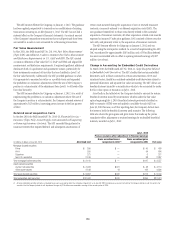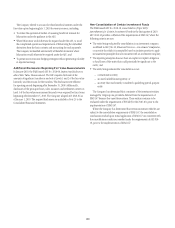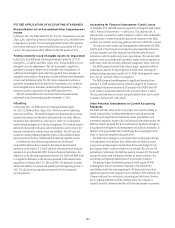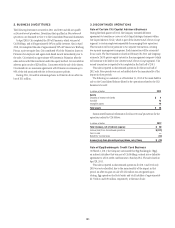Citibank 2012 Annual Report Download - page 173
Download and view the complete annual report
Please find page 173 of the 2012 Citibank annual report below. You can navigate through the pages in the report by either clicking on the pages listed below, or by using the keyword search tool below to find specific information within the annual report.151
When Citi’s monitoring of the loan indicates that the guarantor’s
wherewithal to pay is uncertain or has deteriorated, there is either no
change in the risk rating, because the guarantor’s credit support was never
initially factored in, or the risk rating is adjusted to reflect that uncertainty
or deterioration. Accordingly, a guarantor’s ultimate failure to perform or
a lack of legal enforcement of the guarantee does not materially impact
the allowance for loan losses, as there is typically no further significant
adjustment of the loan’s risk rating at that time. Where Citi is not seeking
performance under the guarantee contract, it provides for loans losses as if
the loans were non-performing and not guaranteed.
Consumer loans
For Consumer loans, each portfolio of non-modified smaller-balance,
homogeneous loans is independently evaluated by product type (e.g.,
residential mortgage, credit card, etc.) for impairment in accordance
with ASC 450-20. The allowance for loan losses attributed to these loans
is established via a process that estimates the probable losses inherent in
the specific portfolio. This process includes migration analysis, in which
historical delinquency and credit loss experience is applied to the current
aging of the portfolio, together with analyses that reflect current and
anticipated economic conditions, including changes in housing prices and
unemployment trends. Citi’s allowance for loan losses under ASC 450-20
only considers contractual principal amounts due, except for credit card
loans where estimated loss amounts related to accrued interest receivable are
also included.
Management also considers overall portfolio indicators, including
historical credit losses, delinquent, non-performing, and classified loans,
trends in volumes and terms of loans, an evaluation of overall credit quality,
the credit process, including lending policies and procedures, and economic,
geographical, product and other environmental factors.
Separate valuation allowances are determined for impaired smaller-
balance homogeneous loans whose terms have been modified in a troubled
debt restructuring (TDR). Long-term modification programs as well as short-
term (less than 12 months) modifications originated beginning January 1,
2011 that provide concessions (such as interest rate reductions) to borrowers
in financial difficulty are reported as TDRs. In addition, loans included in
the U.S. Treasury’s Home Affordable Modification Program (HAMP) trial
period at December 31, 2011 are reported as TDRs. The allowance for loan
losses for TDRs is determined in accordance with ASC 310-10-35 considering
all available evidence, including, as appropriate, the present value of the
expected future cash flows discounted at the loan’s original contractual
effective rate, the secondary market value of the loan and the fair value
of collateral less disposal costs. These expected cash flows incorporate
modification program default rate assumptions. The original contractual
effective rate for credit card loans is the pre-modification rate, which may
include interest rate increases under the original contractual agreement with
the borrower.
Where short-term concessions have been granted prior to January 1, 2011,
the allowance for loan losses is materially consistent with the requirements
of ASC 310-10-35.
Valuation allowances for commercial market loans, which are classifiably
managed Consumer loans, are determined in the same manner as for
Corporate loans and are described in more detail in the following section.
Generally, an asset-specific component is calculated under ASC 310-10-35
on an individual basis for larger-balance, non-homogeneous loans that are
considered impaired and the allowance for the remainder of the classifiably
managed Consumer loan portfolio is calculated under ASC 450 using a
statistical methodology, supplemented by management adjustment.
Reserve Estimates and Policies
Management provides reserves for an estimate of probable losses inherent
in the funded loan portfolio on the Consolidated Balance Sheet in the
form of an allowance for loan losses. These reserves are established in
accordance with Citigroup’s credit reserve policies, as approved by the
Audit Committee of the Board of Directors. Citi’s Chief Risk Officer and
Chief Financial Officer review the adequacy of the credit loss reserves each
quarter with representatives from the risk management and finance staffs
for each applicable business area. Applicable business areas include those
having classifiably managed portfolios, where internal credit-risk ratings
are assigned (primarily Institutional Clients Group and Global Consumer
Banking) or modified Consumer loans, where concessions were granted due
to the borrowers’ financial difficulties.
The above-mentioned representatives for these business areas present
recommended reserve balances for their funded and unfunded lending
portfolios along with supporting quantitative and qualitative data. The
quantitative data include:
Estimated probable losses for non-performing, non-homogeneous
exposures within a business line’s classifiably managed portfolio and
impaired smaller-balance homogeneous loans whose terms have
been modified due to the borrowers’ financial difficulties, and it was
determined that a concession was granted to the borrower. Consideration
may be given to the following, as appropriate, when determining this
estimate: (i) the present value of expected future cash flows discounted at the
loan’s original effective rate; (ii) the borrower’s overall financial condition,
resources and payment record; and (iii) the prospects for support from
financially responsible guarantors or the realizable value of any collateral.
In the determination of the allowance for loan losses for TDRs, management
considers a combination of historical re-default rates, the current economic
environment and the nature of the modification program when forecasting
expected cash flows. When impairment is measured based on the present
value of expected future cash flows, the entire change in present value is
recorded in the Provision for loan losses.



